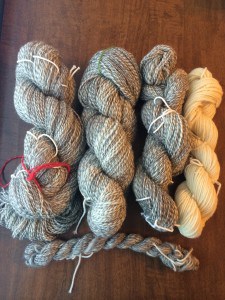I finally finished the yarn I have been spinning that is made from one ply of pin-drafted undyed cream-colored wool from Ohio Valley Fibers and one ply of an undyed brown 50% Shetland / 50% Mohair blend from Psalm 23 Farm. I bought both fibers in April at The Fiber Event in Greencastle, Indiana and started the spinning for this yarn at the beginning of May. I finished plying on July 29, but got so much yardage that it took a while to wrap it on to my niddy noddy so I could set the twist. I just finished setting the twist yesterday.
Official Stats
- Spinning Twist: S (clockwise)
- Plying Twist: Z (counter-clockwise)
- Ratio: 5:1
- Fibers
- Ohio Valley pin-drafted medium wool
- Psalm 23 Farms 50% Shetland / 50% Merino combed top
- Finished skeins
- 34 yards, 11 grams
- 300 yards, 109 grams
- 418 yards, 149 grams
- 510 yards, 153 grams
- 104 yards, 45 grams n-plied Ohio Valley wool that was leftover after plying the two fibers together
- Ravelry Stash page
Project Notes
This yarn took a lot longer to finish than I expected. It was part of my OWL proposal for this term of HPKCHC. I was going for a Care of Magical Creatures: Bowtruckles Option OWL, which requires you to craft with a new-to-you skill. Since I got my wheel only 10 days before the start of the term, I proposed wheel spinning for my OWL. I practiced on the wheel, first with 2 ounces of superwash merino (see blog post, Only a Mama), then spun the first 8 ounces of the Ohio Valley pin-drafted wool (blog post, Getting Better). It took me about an hour to spin an ounce of fiber. I looked at the COMC: Bowtruckles OWL proposals of the other two HPKCHC students who had wheel spun for this OWL and both of them proposed spinning a pound of fiber. But since the pin-drafted wool spun up so quickly, and 8 ounces of my OWL proposal was that same fiber, I thought 16 ounces would not be OWL-worthy (3 months worth of crafting) and proposed a total of 24 ounces. I was wrong; since I was wrong, I did not complete my OWL this term.
I lost track of how long it took me to spin the second 8 ounces of the Ohio Valley pin-drafted wool, but it was certainly more than an hour an ounce. This was mostly because I spun much thinner singles with the second 8 ounces than I did with the first 8 ounces. The Psalm 23 Fiber took longer still. In addition to spinning finely, I had to stop regularly to pick out vegetable matter. The vegetable matter was fairly small and not visible when I purchased the fiber. As I spun, it stuck out from the single and became glaringly obvious. This may not annoy anyone else, but it bothered me. I picked out as much as I could as I was predrafting, but did not get it all, so regularly had to stop spinning to pick out what I had missed.

Plying also took a really long time. The 34 yard skein is the beginning of my plying. The singles kept breaking on me and those 34 yards have 5 or 6 knots. I was frustrated and set the plying aside for awhile. My friend Stacy suggested that the singles were breaking because I had underspun them. I looked at them carefully and decided that the Ohio Valley wool was underspun, but the Psalm 23 Fiber was fine. I respun all the Ohio Valley Fiber, which took me about 6 hours. After that, I had no problem with plying, but it still took a long time. I had a lot of yards of singles to ply together! It took about 12 hours to do all the plying.
I should also note that when I first started plying, I was using my tensioned lazy Kate. After I respun the Ohio Valley Fiber, I did not use the tensioned lazy Kate. Instead, I used the lazy Kate that is built in to my spinning wheel. It is probable that the tension on my lazy Kate was not appropriately adjusted when I was plying, and this was part of my problem.
I am pleased with how the yarn came out. It is still a bit thick and thin, but it is much more consistent than before. I am most interested in spinning fingeringweight and laceweight yarns as these are the weights I most often use for knitting. The thinnest parts of this yarn came out at laceweight, though it is mostly thicker than that, averaging about a sportweight yarn. I am thinking I am going to try dyeing it. I have not dyed anything other than a naturally cream-colored yarn and I am curious to see how a naturally dark-colored yarn takes dye. I am keeping the 34 yard knotted mess of my initial plying to use for a dyeing swatch. I have not decided what I will knit with this fiber, but I’m thinking a shawl if I can find one that will work with a thick and thin yarn.


